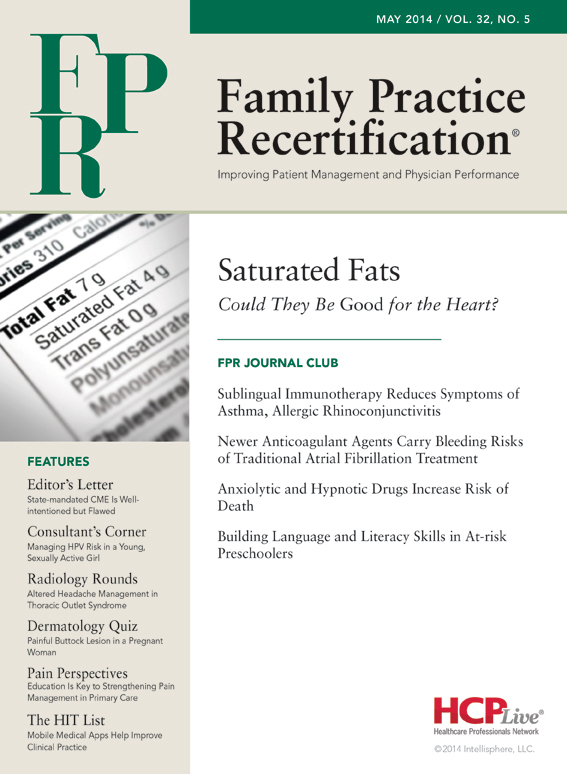Publication
Article
Family Practice Recertification
Building Language and Literacy Skills in At-risk Preschoolers
Author(s):
Using trained language assistants for 18 structured home visits improved phonological skills and letter knowledge in children with language delay, which has the potential to enhance literacy in this population.
Review
Wake M, et al. Randomized trial of a population-based, home-delivered intervention for preschool language delay. Pediatrics 2013 Oct;132(4):e895-904. http://www.ncbi.nlm.nih.gov/pubmed/24043276.
Study Methods
This randomized control trial was built into a cross-sectional assessment of language delay among children in Melbourne, Australia, who had previously taken part in early childhood language studies called Let’s Learn Language1 and Let’s Read.2
Testing was conducted across 3 socioeconomic tiers defined by the Australian census-derived Socioeconomic Indexes for Areas of Disadvantage (SEIFA). As the children turned 4 years old, families from the prior trials were re-recruited and baseline assessments were conduced.
Children were eligible for the study if their receptive and/or expressive language scores on the Clinical Evaluation of Language Fundamentals—Preschool, 2nd Edition (CELF-P2) at age 4 were more than 1.25 standard deviation (SD) below the average, while prospective participants were excluded if they had known intellectual disability, major medical conditions, hearing loss, autism spectrum disorders (ASD), or parents with insufficient English language skills.
Intervention and Control
Approximately 1,500 children received baseline assessments at age 4, but only 200 participants were included in the study and randomized to intervention (n=99) or control groups (n=101).
Within 2 months of the baseline assessment, trained “language assistants” comprised of psychology or sociology university graduates began 18 home-based intervention sessions focused on narrative skills, vocabulary and grammar, phonological awareness, and pre-literacy proficiencies. Each session followed a specific framework, including a review of the previous week, introduction of new activities directed at both the child and parents, and activities for home practice. However, programs were individualized based on the severity of delay in each participant.
When the children reached age 5, data from 93 intervention and 91 control participants were available for analysis. Primary outcomes were defined as expressive and receptive language, while secondary outcomes included phonologic awareness skills, letter knowledge, social language use, health-related quality of life, and behavior. Although some outcomes were measured using formal standardized assessments like the CELF-P2, others were evaluated through parent proxy.
Results and Outcomes
In the intervention group, there were significant improvements on the secondary outcomes of phonological awareness and letter knowledge and small improvements on the primary outcomes of expressive and receptive language skills — an effect unchanged by the etiology of language delay, specific versus nonspecific language delay status, or the mother’s education level.
Conclusion
Using trained language assistants for 18 structured home visits improved phonological skills and letter knowledge in children with language delay, which has the potential to enhance language and literacy in this population.
Commentary
Language development is a critical task of early childhood, as it facilitates communication skills, socialization, and future learning. Though the definition of language delay is often ambiguous, children whose abilities fall 1 SD below the mean are cause for clinical concern.3 The incidence of language delay among 2-year-olds is approximately 10-15%, though this number falls to 4-5% after age 3.4
For children under 3 years of age, the United States offers screening for developmental concerns, including language delay. Those who qualify for early intervention services may receive language therapy through the Head Start program until age 3, at which time the local public school system assumes responsibility for subsequent evaluations and services.
Since the language program utilized in this study improved phonemic awareness and letter recognition significantly, the authors hypothesized their intervention could equip at-risk preschool-aged children with valuable literacy skills. Given that language impairment strongly predicts future difficulty in literacy, this is clinically significant. However, the authors suggested the finding might not be applicable to families with economic disadvantages or insufficient English language skills.
Although the assessment performed at age 5 did not show improvements in the primary outcomes of receptive and expressive language skills following the intervention, the authors noted the tool used to measure the outcomes might have been too insensitive to capture subtle short-term change. Consequently, future studies should determine how receptive or expressive language improvements evolve and whether the identified improvements in early literacy skills confer any long-term advantages.
Despite the ambiguity regarding the primary outcomes and long-term benefits of this intervention program, the secondary endpoints are important. Since this program was relatively low in cost to institute and well received by families, it may provide a foundation for improved literacy skills in a population of at-risk children.
References
1. Wake M, et al. Outcomes of population based language promotion for slow to talk toddlers at ages 2 and 3 years: Let’s Learn Language cluster randomised controlled trial. BMJ. 2011;343:d4741. http://www.bmj.com/content/343/bmj.d4741.
2. Goldfeld S, Napiza N, Quach J, Reilly S, Ukoumunne OC, Wake M. Outcomes of a universal shared reading intervention by 2 years of age: the Let's Read trial. Pediatrics. 2011 Mar;127(3):445-53. http://pediatrics.aappublications.org/content/127/3/445.abstract.
3. Sices L. Overview of expressive language delay ("late talking") in young children. In: UpToDate, Augustyn M, Torchia M (Eds), UpToDate. Waltham, MA, 2014. http://www.uptodate.com/contents/overview-of-expressive-language-delay-late-talking-in-young-children.
4. Stein MT, Parker S, Coplan J, Feldman H. Expressive language delay in a toddler. J Dev Behav Pediatr. 2001 Apr. 22(2 Suppl):S99-103. http://journals.lww.com/jrnldbp/pages/articleviewer.aspx?year=2001&issue=04001&article=00020&type=abstract.
About the Authors
Kristin Gerson, MD, is a recent graduate of the University of Massachusetts Medical School in Worcester, MA.
She was assisted in writing this article by Frank J. Domino, MD, Professor and Pre-Doctoral Education Director for the Department of Family Medicine and Community Health at the University of Massachusetts Medical School and Editor-in-Chief of the 5-Minute Clinical Consult series (Lippincott Williams & Wilkins).






